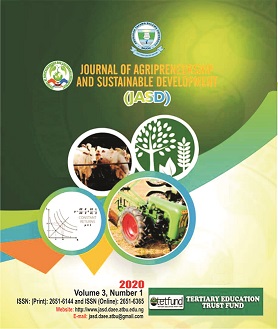ANALYSIS OF SUSTAINABILITY OF SUGARCANE FARMING IN NIGERIA
DOI:
https://doi.org/10.59331/jasd.v3i1.105Keywords:
Elasticity, Flood areas, Inputs, Sugarcane, SustainabilityAbstract
The study was conducted to analyze sustainability of sugarcane farming in Nigeria. Kano State was purposively selected with a sample size of 54 sugarcane farmers using randomized sampling procedure. The data were analyzed using descriptive statistics, farm budgeting and regression analysis. The result showed that 94% of the respondents were male, with an average age of 39 years. The mean household of the farmers was 8 persons. The average farm size was 2.3ha; it cost N33,224.22 to produce sugarcane per hectare with revenue of N36,706.17; the gross margin was N3,481.95 and the investment rate of return was 0.10. The findings further disclosed that age, household size, education and labour were significant (P<0.05) and influenced the output of sugarcane farming in Nigeria. The results also reveal that land, sugarcane setts, fertilizer, insecticide and labour had ratios of 2.57, 33.44, 6.55, 1.630, and 0.27, respectively. The study revealed the constraints to sugarcane production in Nigeria to include, small farm holdings, high cost of inputs, inadequate credit, land tenure problem and poor extension services. It was concluded that even though sugarcane production is profitable, land, sugar cane sett, fertilizer and insecticide were underutilized and labour was over utilized. The study recommended that the farmers should increase the use of the underutilized factors and reduce the over utilized inputs; and also, the Government should review land ownership policies and subsidize farming inputs.
Downloads

Downloads
Published
How to Cite
Issue
Section
License
Copyright (c) 2022 Journal of Agripreneurship and Sustainable Development

This work is licensed under a Creative Commons Attribution 4.0 International License.






